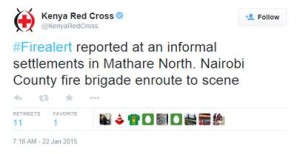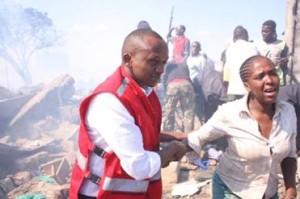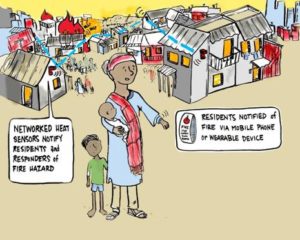By Abi Weaver, Global Technology Project Director, American Red Cross
Last weekend, volunteers in Omaha walked door-to-door, helping families install and test smoke alarms as part of the American Red Cross Home Fire Preparedness Campaign, which aims to reduce deaths and injuries caused by home fires by 25% in five years. More than 8,400 miles away, Kenya Red Cross volunteers may soon be providing a similar lifesaving service in Nairobi’s slums.
It’s challenging to estimate how many slum fires Kenya experiences each year because so many go unreported. But just a quick scroll through the Kenya Red Cross Twitter stream and you’ll notice they regularly occur because people are cooking with open flames indoors, burning trash, overextending faulty wires or trying to keep warm. Rapid and haphazard community development has also forced homes dangerously close together, and once they start, fires spread easily throughout the settlement.

On top of this, the density of Nairobi’s slums makes evacuations chaotic and dangerous. Pathways between homes are narrow and often blocked. Imagine a large-scale labyrinth with limited visibility and dozens of obstacles in your way. Getting out of your home when a fire starts and to a safe location within two minutes, as firefighters recommend, is nearly impossible.
Earlier this year, I spent some time with residents of three settlements in Nairobi to better understand the fire risk and help find innovative solutions to this overwhelming problem.
When fires occur, residents shout, ring bells, honk horns, crank sirens and use social media to alert others. Some residents risk their lives to suppress the fire using blankets and buckets, others douse their unaffected homes with water to stop the spread.
Most people didn’t know who to call to help stop fires. And professional firefighters, if they are even available, have a difficult time finding and getting to homes. Within minutes, hundreds of residents can be left devastated and homeless.
Very few have insurance. And after a fire, forced eviction or rent increases are common. Many end up leaving their communities and families are separated for prolonged periods of time.
Despite the sobering realities of the slums, it was easy to stay optimistic. The creativity and entrepreneurial spirit of the local residents was without equal, and together, we identified an emerging technology tool to complement the Kenya Red Cross’ current risk reduction programs—low cost fire sensors that are networked to each other.
An Emerging Technology Solution
In the future, they could detect a fire early, distinguishing between smoke and flames, and sound alarms across the network via SMS and broadcast to alert nearby homeowners. They could also directly notify professional firefighters (or an informal brigade of citizen volunteers) and provide GPS data for the location of the fire.

Almost immediately, we took our enthusiasm and requirements to a group of students at Texas A&M University, and we asked them to help design a custom prototype for the fire sensors, inspired by those developed in South Africa. During an initial design session, they also thought of ways the he at sensors could help reduce the number of false alarms caused by smoke detectors in the US.

On March 6, the Aggies will head back to the lab for second design session and help move us one more step toward this dream. We have a lot of work ahead of us before we can claim victory, but we have a great need propelling us forward.
Want to learn more about this innovation initiative and the other emerging technology projects planned in 2015? Visit www.tech4resilience.blogspot.com for regular updates on our progress and read our Vision for the Humanitarian Use of Emerging Technology for Emerging Needs.

